| Under Function Basics, we saw the departure between a relation and a function.
In either case, nosotros are dealing with relationships expressed as ordered pairs. 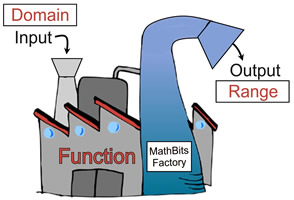 | All of the values that can get into a relation or function (input) are chosen the domain . All of the values that come out of a relation or function (output) are called the range .
Range may also exist referred to as "image". Annotation that both relations and functions accept domains and ranges. | The domain is the set of all first elements of ordered pairs (x-coordinates).
The range is the gear up of all second elements of ordered pairs (y-coordinates).
Simply the elements "used" by the relation or role constitute the range.
 | Domain: all x-values that are to be used (independent values).
Range: all y-values that are used (dependent values). |   | State the domain and range of the following relation:
(center color, student'south name).
A = {(blue,Steve), (green,Elaine), (brown,Kyle), (blueish,Marsha), (brown,Miranda), (dark-green, Dylan)}
State whether the relation is a part. | Solution: Domain: {blue, green, brown}. Range: {Steve, Elaine, Marsha, Miranda, Dylan}.
No, this relation is non a function. The eye colors are repeated.   State the domain and range of the following relation: {(ane,3), (-2,7), (iii,-3), (4,5), (ane,-3)}.
Land whether the relation is a function. Solution: Domain: {-ii, 1, iii, 4}. Range: {-three, three, five, 7}.
While these listings appear in ascending lodge, ordering is not required. Practise non, however, duplicate an element.
No, this relation is not a function. The x-value of "1" had two corresponding y-values (3 and -3).   State the domain and range for the elements matched in the diagram beneath.
Land whether the matches class a function. 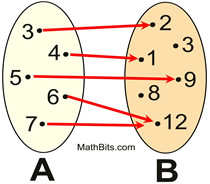 | Solution: Domain: {3, 4, five, half dozen, 7}. Range: {i, two, 9, 12}.
Notation that the range is only the elements that were used.
Yes, the relation {(three,2), (4,ane), (5,9), (6,12), (7,12)}is a function.
No ten-value repeats. FYI: Set B = {i, 2, three, 8, nine, 12} may be called the co-domain. Information technology is the "possible" set from which output from the relation will autumn. The co-domain is NOT necessarily the same equally the range. At that place may be values in the co-domain that are never used. |   Land the domain and range associated with the scatter plot shown beneath.
State whether the besprinkle plot is a function. 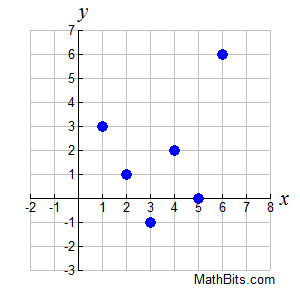 | Solution: Domain: {i, 2, 3, iv, 5, 6}.
(Be careful not to simply listing the domain as 1 < ten < half-dozen, which would imply ALL values betwixt ane and 6 inclusive, unless you specify "10 is an integer".) Range: { 0, -i, 1, 2, 3, vi} Yeah, this is a role. No x-values repeat, and it passes the Vertical Line Test for functions. Note: Graphs that are composed of a series of dots, instead of a continued curve, are referred to every bit discrete graphs. A discrete domain is a set of input values that consist of just certain numbers in an interval. |   Land the domain and range associated with the graph below.
Country whether this relation is a function. 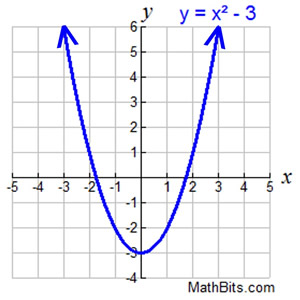 | Solution: Domain:  (all real numbers). (all real numbers).
The arrows indicate that the graph continues off the visible grid, so assume that all existent numbers are involved. Range: y > -3 (may as well be written as  ) ) Yep, this relation is a function, since it passes the Vertical Line Test for functions. Note: Graphs that are composed of a connected curve are referred to as continuous graphs. A continuous domain is a set of input values that consists of all numbers in an interval. |   Land the appropriate domains for the functions shown below.
When functions are expressed as "rules" (formulas), be sure to think near possible "trouble" spots earlier stating the domain. Remember that the domain is the x-values that are allowed by the function'southward equation. In nearly cases, a graph will assist testify the domain.

 | Information technology may be necessary to restrict a domain to ensure the beingness of a function. | Nosotros know not all graphs are functions. As we saw in Case v, information technology is often possible, however, to create "functions" from non-role graphs by restricting which domain elements are used. 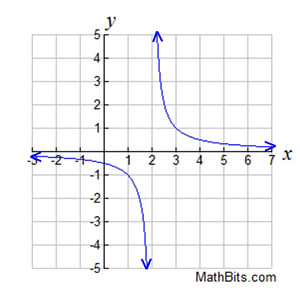 | The graph at the left is  . . At first glance, it appears that this graph passes the Vertical Line Test and is a "part". Just information technology is NOT a function over the domain of Real numbers.
This graph is undefined when x = 2, considering substituting 2 into the function will create a nothing denominator. If we restrict the domain to be "all Real numbers excluding ii", our relation can be called a function. Domain of the role:  |  | It may be necessary to restrict the range to ensure the being of a function. | The graph of the relation  is shown beneath on the left. It is clear that this relation fails the Vertical Line Test and is Non a function. We can, however, separate this graph into its two parts and create two divide functions. is shown beneath on the left. It is clear that this relation fails the Vertical Line Test and is Non a function. We can, however, separate this graph into its two parts and create two divide functions.

 | 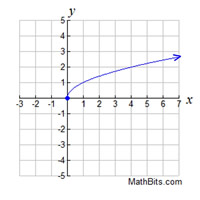
 | 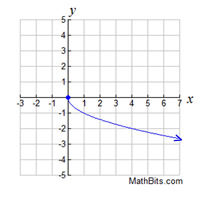
 | These separated graphs each pass the Vertical Line Test and are functions. The domain for both functions is x > 0. The range of the commencement part is y > 0, and the second function is y < 0. |  |  | If a domain is not stated, it is generally assumed to be all real numbers. |

Note: The re-posting of materials (in role or whole) from this site to the Internet is copyright violation
and is not considered "off-white utilise" for educators. Please read the "Terms of Employ". |






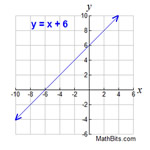
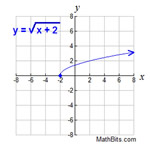

 .
.




0 Response to "how to find the domain and range of a relation"
Post a Comment